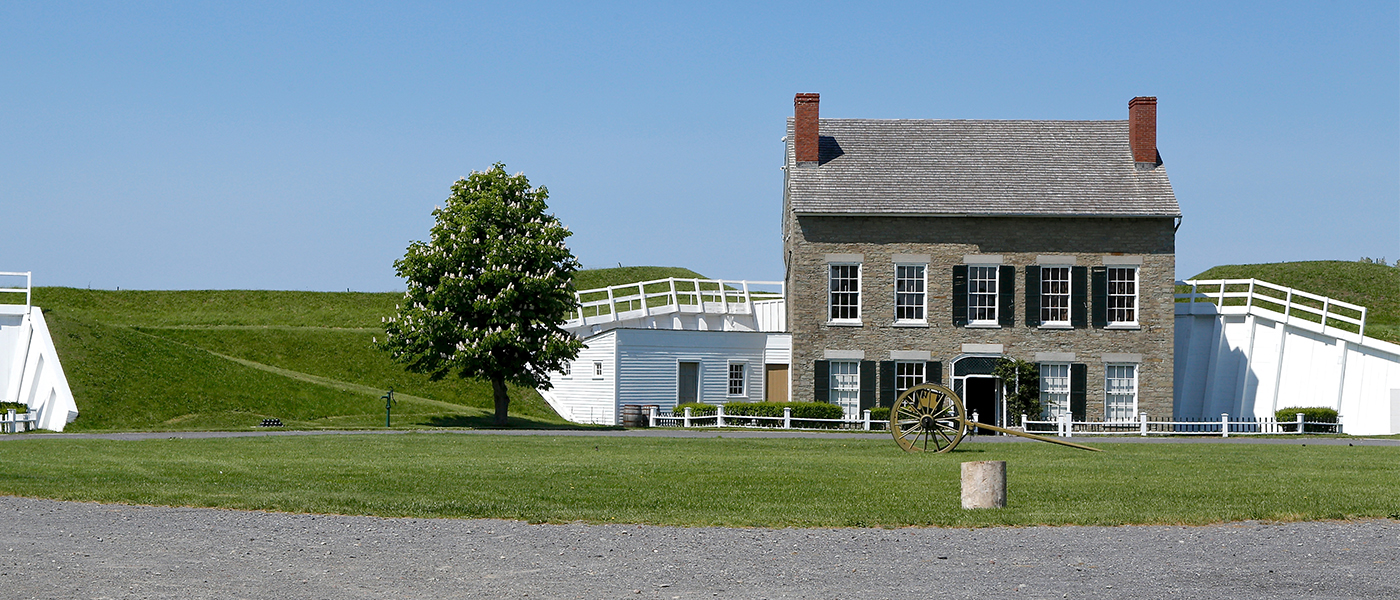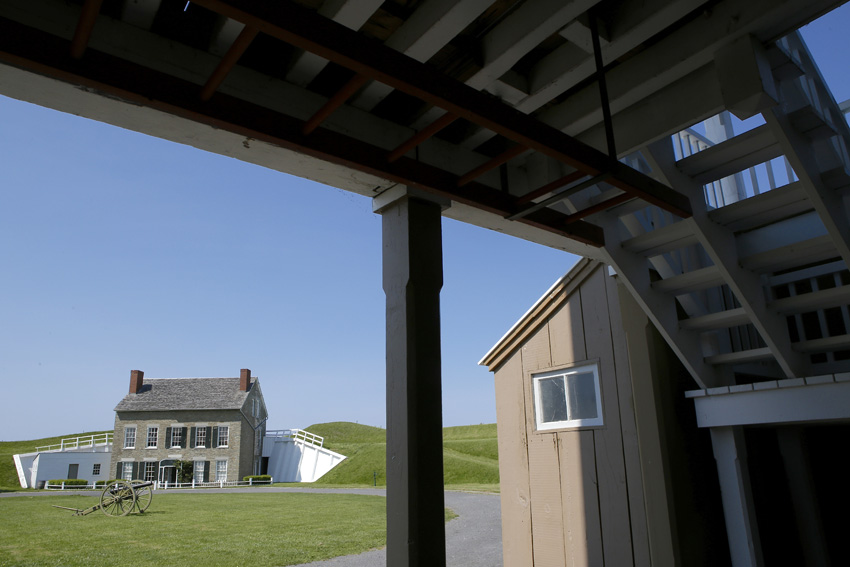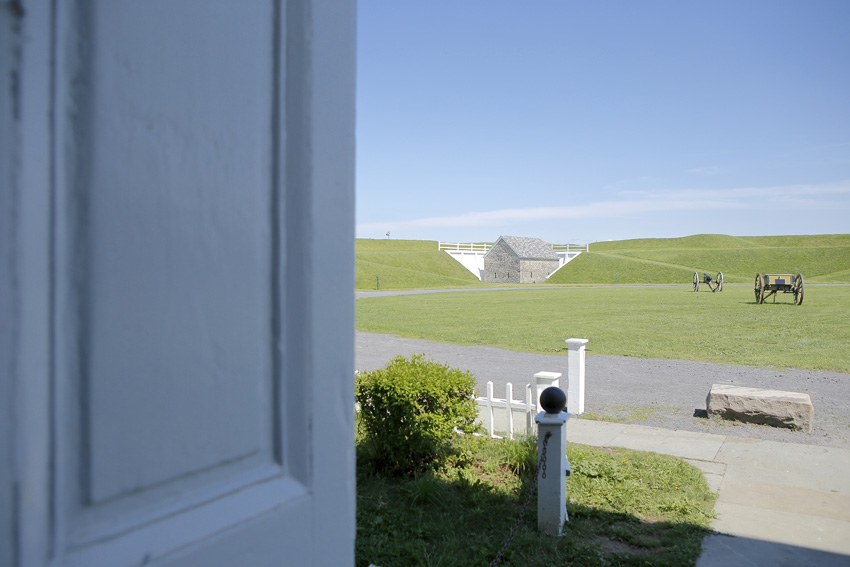Bad Fences, Good Neighbors: Oswego’s role in sheltering WWII refugees
By
Posted on

The story of European refugees and their journey to Oswego, where they took emergency shelter from their war-torn homeland
_________________________________
As the train, which had transported the refugees from New York City to Oswego, rumbled and screeched to a halt in front of their new home, a military policeman yelled over the din that nobody was to move until orders were given. The fence topped with barbed wire, which surrounded Fort Ontario, was surely the worst kind of welcome to survivors of concentration camps. Yet to some, it felt like a deliverance. A young Austrian woman named Kitty Kaufman said, “If you ask me, I feel safer behind a fence; even in America.” The story of the only Emergency Refugee Shelter in the country during World War II has been told before. However, the United Nations recently found that the number of people displaced by violence and war has never been recorded higher, so perhaps it deserves to be heard again; although this time from a different perspective. Abstract fears and sensational headlines about the danger of foreigners is one thing, but the experience of living with and next-door to living, breathing and thriving neighbors is surely something else, as many residents of Oswego could and did attest. D-Day had happened earlier that month in June 1944 when President Roosevelt announced that the United States would accept 1,000 people as his “guests” from war-ravaged Europe. Anti-Semitism was still rampant and there was plenty of pushback to those citizens and organizations who had been clamoring for action for years. Partially to free up space in Italian refugee camps and partially as a humanitarian gesture, a “token refuge,” as it has been called by Susan Lowenstein, would be provided. These lucky few, out of 3,000 who applied, would not be invited to settle here. In fact, they signed contracts stating they would be here only temporarily, and would live in Fort Ontario, an edifice which had existed longer than the United States. During the war, African-American, and then illiterate troops were stationed there, and residents of Oswego, including the Chamber of Commerce, had lobbied the federal government to make use of it again. They got their wish. The two and a half week trip aboard the Army transport Henry Gibbon across the embattled Atlantic was, in a way, a metaphor for and microcosm of future tensions among the evacuees. Although their famous escort Ruth Gruber started English classes right away, divisions were stark. People of 18 nationalities who spoke 21 languages were on the ship, and although only 100 were not Jewish, there was conflict between Orthodox and Reform Jews as well. Many were children and elderly and had been on the run from war for almost a decade; tensions were high. In one incident, a Polish child running on the deck tripped over a Yugoslavian man’s leg. “Polako, polako!” he chided the boy, “go slowly!” An easy mistake to make, but less easy to clean up. The light began to shine for them in small and unexpected places as they walked onto the pier in New York. The solemn military police were worrisome for sure, but one MP, recent immigrant Herbert Altman, broke rank when he saw his parents-in-law among the refugees and ran to embrace them. After they arrived at the Fort, Gruber and other administrators, including the camp director Joseph Smart informed the crowd that they would be quarantined. Unable even to visit American family members who had read of their arrival in the newspaper, freedom rang — across the fence. However, as soon as they arrived, residents of the small town flocked to the barrier. They were shocked at what they saw. Some brought clothes. Many brought children’s shoes, which were particularly needed. Others brought cigarettes or beer to pass over the fence. A young waitress named Geraldine Rossiter, who had come to the Fort by bike, saw the refugee children’s excitement at her “beecycla.” A human pyramid managed to pass it over the fence. Geri went home, changed into old clothes, and snuck under the fence through a hole that had been used by Oswego kids to get to a swimming area. She made fast friends with the beautiful young Yugoslavian Edith Semjen, who had entertained troops on the Henry Gibbons with a rendition of “You are my Sunshine” accompanied by an accordion. Entertainment and culture would become a regular part of shelter life. Among the refugees was Otto Presser, an Austrian performer Gruber compared to Eddie Cantor and Leo Mircovic, a baritone in the Zagreb National Opera who insisted on dressing to impress at all times. Both on the ship and at the Fort, plays were performed and songs were sung. It was incomprehensible to many that they were not allowed to leave the camp for the month of the quarantine. The barracks that housed them were simple, in keeping with the President’s directive that they be “protected,” not coddled. A cot, table and little else. Still, because of the barrier between members of the town and their new neighbors, rumors began to circle suggesting that inside the walls these Europeans were being treated to amenities such as washing machines and private bathtubs, which Oswego residents didn’t necessarily have themselves. Joseph Smart decided that to dispel the rumors, there would be an open house that September. That way the townspeople could see for themselves that these were not lavish accommodations. Relatives of the group were just happy to see them. More than a third of the refugees had family members in America already, many of whom were serving in the military. Chaim Fuchs, a former prisoner in Dachau, hugged his son Gustave Fox so tightly that his glasses snapped. The editor of the Oswego Palladium-Times and the president of the Chamber of Commerce Edwin Waterbur still received some angry letters, but the open house was largely a success. He would later estimate that most people, about 90 percent, were positive about the Safe Haven. One other positive outcome of the open house was that the high school principal, Ralph Faust, visited the camp and lobbied to enable the young people to enter school, which 193 of them soon did. When Eleanor Roosevelt came and heard that the few college-age students were not enrolled at Oswego, she intervened and they were able to do so. Still, there were many criticisms about the camp. There was a chapel on the Fort grounds, but that wouldn’t help most of the people there. At first food was plentiful, but it became less so as health was regained. Even then, “white bread?” people wondered. That Oswego winter was worse than usual. The government planned to allocate jobs to refugees in a way that would make the camp self-sufficient. Yet the guests often had a hard time working in the conditions provided, especially when wages were the same if a doctor or a laborer performed the tasks. Pay was the same for administrative work and shoveling coal to keep warm in the drafty barracks. As Albert Hirt, a Polish judge commented, “I am a judge, so I shovel coal in America.” An Oswego Advisory Committee led by a lawyer, Catholic priest and Principal Faust helped connect businesses in town with the refugees. Working within the guidelines of government, companies were allowed to sell their goods inside the camp at a makeshift canteen. Because of the labor shortage during the war, workers were desperately requested by local employers, but were only allowed to work at an orchard after farmers complained that their crops were failing. Imagine the shock of the refugees when they saw that German prisoners were working nearby for the same wages! The status of POWs was more secure than the residents of Fort Ontario. Once the quarantine was lifted, Fort residents were allowed out with six-hour passes. Families opened their doors to entertain their guests, and the refugees became familiar with the town. The 11:30 curfew was stretched to midnight so they could finish the last movie at 11:45 and walk back to the shelter. Those who desired more snuck out of the Fort, like the teenaged Adam Munz, who hitch hiked to New York City many times before he was caught. A shop teacher at the high school brought some students to Syracuse to marvel at American industry. Even though they were protected, it was not certain that their safety would last. After all, they had signed documents — which were confusing in translation — stating that they would return to Europe when the war was over. Eventually, their fates were put before a congressional subcommittee hearing. Children who had become boy scouts told the old men that they loved America and wanted to stay. Fourteen Oswego residents testified in favor of the refugees. But in the end, it was another executive order, this time by President Truman, which allowed them to remain in the country as part of the immigration quota. Some refugees decided to go back to Europe, but most decided to stay. Many became well-known and successful, while others led comfortable lives. Despite many troubling hurdles, their story is a testament to what can happen when biases are set aside and a chance is taken on those who need help. Who am I speaking of? I mean both the refugees and Americans themselves. Recently the Safe Haven Museum of Oswego has begun a project to collect the memories of townspeople and their family who have personal memories and stories they would like to share. Please contact the museum for information at www.safehavenmuseum.com.















